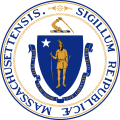| Elections in Massachusetts |
|---|
 |
Massachusetts held its elections November 5, 1810. Massachusetts law required a majority for election. This was not met in the 15th district necessitating a second election on April 1, 1811.
Contents
| District | Incumbent | This race | |||
|---|---|---|---|---|---|
| Representative | Party | First elected | Results | Candidates [a] | |
| Massachusetts 1 "Suffolk district" | Josiah Quincy | Federalist | 1804 | Incumbent re-elected. [1] | √ Josiah Quincy (Federalist) 68.9% David Tilden (Democratic-Republican) 31.1% |
| Massachusetts 2 "Essex South district" | Benjamin Pickman Jr. | Federalist | 1808 | Incumbent retired. New member elected. Federalist hold. | √ William Reed (Federalist) 53.6% Daniel Kilham (Democratic-Republican) 46.4% |
| Massachusetts 3 "Essex North district" | Edward St. Loe Livermore | Federalist | 1806 | Incumbent retired. New member elected. Federalist hold. | √ Leonard White (Federalist) 62.6% Thomas Kitteridge (Democratic-Republican) 33.5% Nehemiah Cleveland (Federalist) 3.9% |
| Massachusetts 4 "Middlesex district" | Joseph Bradley Varnum | Democratic-Republican | 1794 | Incumbent re-elected. | √ Joseph Bradley Varnum (Democratic-Republican) 69.2% Loammi Baldwin Jr. (Federalist) 30.8% |
| Massachusetts 5 "Hampshire South district" | William Ely | Federalist | 1804 | Incumbent re-elected. | √ William Ely (Federalist) 70.4% Samuel Fowler (Democratic-Republican) 29.0% |
| Massachusetts 6 "Hampshire North district" | Samuel Taggart | Federalist | 1803 | Incumbent re-elected. | √ Samuel Taggart (Federalist) 72.1% Solomon Snead (Democratic-Republican) 27.9% |
| Massachusetts 7 "Plymouth district" | Charles Turner Jr. | Democratic-Republican | 1808 | Incumbent re-elected. | √ Charles Turner Jr. (Democratic-Republican) 53.5% William Baylies (Federalist) 46.5% |
| Massachusetts 8 "Barnstable district" | Gideon Gardner | Democratic-Republican | 1808 | Incumbent retired. New member elected. Democratic-Republican hold. | √ Isaiah L. Green (Democratic-Republican) 57.1% Francis Rotch (Federalist) 42.7% |
| Massachusetts 9 "Bristol district" | Laban Wheaton | Federalist | 1808 | Incumbent re-elected. | √ Laban Wheaton (Federalist) 51.8% Nathaniel Morton (Democratic-Republican) 48.0% |
| Massachusetts 10 "Worcester South district" | Joseph Allen | Federalist | 1810 (Special) | Incumbent retired. New member elected. Federalist hold. | √ Elijah Brigham (Federalist) 53.5% John Spurr (Democratic-Republican) 46.4% |
| Massachusetts 11 "Worcester North district" | Abijah Bigelow | Federalist | 1810 (Special) | Incumbent re-elected. | √ Abijah Bigelow (Federalist) 70.6% Timothy Whiting (Democratic-Republican) 28.5% |
| Massachusetts 12 "Berkshire district" | Ezekiel Bacon | Democratic-Republican | 1807 (Special) | Incumbent re-elected. | √ Ezekiel Bacon (Democratic-Republican) 56.1% Thomas Ives (Democratic-Republican) 43.9% |
| Massachusetts 13 "Norfolk district" | Ebenezer Seaver | Democratic-Republican | 1803 | Incumbent re-elected. | √ Ebenezer Seaver (Democratic-Republican) 63.2% Timothy Jackson (Federalist) 21.2% James Richardson 10.2% James Mann 4.2% Others 1.2% |
| Massachusetts 14 "York district," District of Maine | Richard Cutts | Democratic-Republicans | 1801 | Incumbent re-elected. | √ Richard Cutts (Democratic-Republican) 62.7% Cyrus King (Federalist) 37.3% |
| Massachusetts 15 "Cumberland district," District of Maine | Ezekiel Whitman | Federalist | 1808 | Incumbent lost re-election. New member elected. Democratic-Republican gain. | First ballot November 5, 1810: Ezekiel Whitman (Federalist) 47.8% [b] William Widgery (Democratic-Republican) 47.8% [b] Others 4.4% Second ballot April 1, 1811: √ William Widgery (Democratic-Republican) 53.2% Ezekiel Whitman (Federalist) 46.8% |
| Massachusetts 16 "Lincoln district," District of Maine | Orchard Cook | Democratic-Republican | 1804 | Incumbent retired. New member elected. Democratic-Republican hold. | √ Peleg Tallman (Democratic-Republican) 61.1% Alden Bradford (Federalist) 38.9% |
| Massachusetts 17 "Kennebec district," District of Maine | Barzillai Gannett | Democratic-Republican | 1808 | Incumbent re-elected. | √ Barzillai Gannett (Democratic-Republican) 60.5% Thomas Rice (Federalist) 39.5% |